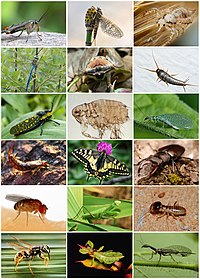
Photo from wikipedia
Phoresis is the interspecific symbiotic association in which one of two participants, the phoront, utilises the other participant in the association (the host) for mechanical transport. The association is seldom… Click to show full abstract
Phoresis is the interspecific symbiotic association in which one of two participants, the phoront, utilises the other participant in the association (the host) for mechanical transport. The association is seldom obligatory although it may be a common occurrence involving certain specific participants. Examples include flightless arthropods such as mites and pseudoscorpions being transported by larger winged insects, or between small flightless insects and larger species. The transport may be occasional and facultative or more fixed – the main function is to facilitate dispersal to other suitable habitats, or to food. Well-known examples include dung beetles (Coleoptera: Scarabaeidae) transporting predatory mesostigmatic mites, and the wingless ‘bee louse’, Braula coeca (Diptera: Braulidae) and its host the honeybee, Apis mellifera (Hymenoptera: Apidae). In the former case, the mites are transported between dung sources where they prey on detritus-feeding mites and fly eggs, while, although the bee louse is an obligatory symphile in honeybee nests where it depends on the bees and their products for food, dispersal between colonies is dependent on absconding bees. However, the lines between phoresis and parasitism become somewhat blurred in cases such as that of B. coeca and A. mellifera since most of the association between them is actually one of benign parasitism by the fly of the host over much of the fly’s life-cycle and phoresis is only involved during dispersal. And, although phoresis is considered to occur at no cost to the host, during the larger, parasitic, part of this association there is obviously some (Kistner 1982). The two important ecological factors that determine a phoretic association are whether the association is facultative or near-obligatory and whether the transport is essential for the success of some stage of the phoront’s life-cycle (Kistner 1982). Most Meloidae larvae are predators of either the brood of various aculeate Hymenoptera (mostly of groundor wood-nesting solitary Apidae, and rarely, of Vespidae: Eumeninae and Sphecidae) or of Orthoptera (mainly Acrididae; one record of Pyrgomorphidae) oothecae (Bologna 1991; Bologna & Pinto 2001). The exception is probably represented by the basal Gondwanan subfamily Eleticinae, the components of which are hypothesised to be endophyte predators in the larval phase (Pinto et al. 1996; Bologna et al. 2001). The family Meloidae belongs to the superfamily Tenebrionoidea and includes about 130 genera and almost 3000 species worldwide. Its classification at subfamily and tribal levels was recently defined by both morphological (adult and larva) (Bologna & Pinto 2001) and molecular characters (Bologna et al. 2008). Southern Africa has a rich meloid fauna with about 35 genera and almost 200 species (Bologna et al. 2018) some of which are associated with bees; these include the wingless ‘oil beetles’ of the genus Meloe and all Nemognathinae, such as Synhoria testacea on carpenter bees (Xylocopa spp.; Apidae: Xylocopinae – Watmough 1983; Bologna & Laurenzi 1994), whereas the widespread and familiar CMR beetle, Hycleus tricolor, and other members of the numerous Mylabrini are associated with locust egg-pods (Skaife 1979) as are the species of Epicauta and Psalydolytta (Epicautini). Meloidae are one of a few groups of insects (also Strepsiptera, certain Hymenoptera and Diptera as well as a few other coleopteran groups) that undergo hypermetamorphosis in which the various larval instars differ significantly from each other in morphology and behaviour. The first instar is termed a triungulin – it is an elongate, long-legged, fast-moving stage whose main function is to locate a host. Species of meloids that prey on bee honey or brood lay eggs on the ground and non-phoretic triungulins look actively for bee nests walking on the soil (tribes Lyttini, Pyrotini, Cerocomini, Eupomphini); in the phoretic groups,
Journal Title: African Entomology
Year Published: 2018
Link to full text (if available)
Share on Social Media: Sign Up to like & get
recommendations!